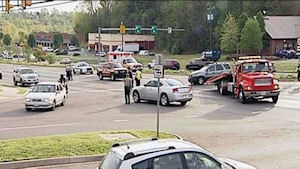About Bacon’s Rebellion
Bacon's Rebellion is Virginia's leading independent portal for news, opinions and analysis about state, regional and local public policy. Read more about us here.
Safety Last?
The McDonnell administration's defense of the $244 million+ Charlottesville Bypass as a boon to traffic safety on U.S. 29 falls apart under close scrutiny.
 by Randy Salzman
by Randy Salzman
With apologies to Lewis Carroll, Charlottesville’s so-called Western “Bypass” project gets “curiouser and curiouser.”
Each argument for the 6.2-mile highway collapses quickly if anyone does third-grade math. This highway built for trucks that trucks can’t use will need another $56 million added to the $244 million already allocated by Virginia to make it usable and then will save truckers, VDOT analyzes, only 66 seconds off the 10-hour drive from Lynchburg to NYC. Would any manufacturer build a plant anywhere on the planet to save a minute off full-day travel, as downstate proponents argue?
VDOT, meanwhile, consistently reports the “Bypass” will do nothing for Albemarle County congestion. Since only 10 to 12 percent of the 47,641 to 51,939 vehicles per day on U.S. 29N pass through the area while 90 percent are local, the intersections along 29N will remain an F level of service after Virginia borrows a fortune to build this expensive four-lane highway, which terminates south of two large, growing neighborhoods and the area’s largest shopping mall.
Recently, the safety argument also fell by the wayside. According to VDOT Traffic Engineer Robert Rasmussen, in a letter forwarded to Albemarle County supervisors, in 2010 there were 260 accidents, or 305 per 100 million vehicle miles of travel, along 3.3 miles of U.S. 29 that the “Bypass” is supposed to relieve.
That’s a stiff rate; one of the highest in the state.
All but a handful of accidents, however, take place at the intersections of Hydraulic and Rio Roads with U.S. 29. If the intersections are excluded, the accident rate drops to 77 per 100 million vehicle miles of travel. Nearly four four in five wrecks would be prevented if Virginia stuck to its original “three-party agreement,” which promoted overpasses at Rio and Hydraulic.
In the early 1990s, VDOT’s three-party agreement sequenced possible projects along U.S. 29 north of Charlottesville and concluded the overpasses should be built first. Only if all the other improvements failed to solve traffic issues, and if funding was available, would a bypass be considered. It was clear then that a bypass would not solve local congestion or local intersection accidents.
Yet in 2012 Secretary of Transportation Sean Connaughton tried to make safety a primary justification for the bypass, stating in correspondence that “900 crashes in Albemarle County” represent “almost 50% of all crashes along the entire Route 29 corridor from North Carolina to the Fauquier/Prince William County Line.”
VDOT’s April 2010 report illustrates the secretary not only can’t fathom the borrowed dollars he’s dumping on future generations, he also has trouble with third-grade math. Of the 7,103 crashes over three years that VDOT notes along U.S. 29 in Virginia, 887 are indeed in Albemarle County. Run the numbers. That’s about one accident in every 12 and nowhere close to “almost 50%.”
Assuming the bypass diverted 10% of all traffic from the congested stretch of U.S. 29, and assuming that there is a direct correlation between the volume of traffic and the number of accidents, building a $300-million “Bypass” might prevent 89 crashes over three years, or about 30 yearly.
Alternatively, assume Rio and Hydraulic Roads were given grade-separated interchanges at an estimated cost of $80 million. The two intersections accounted for 738 of the 887 crashes along that stretch of U.S. 29. Assuming that the interchanges cut the accident rate by 75%, they would prevent 553 crashes over three years, or 184 yearly.
Put another way, fixing Rio and Hydraulic Roads would cost roughly $435,000 per yearly accident prevented, while building the bypass would cost $10 million per yearly accident prevented. Tinker with the assumptions and you still get a vast cost-benefit discrepancy between the two alternatives.
Every single “Bypass” study over 20 years illustrates this kind of fiscal irrationality. VDOT, for example, announced clearly that bypassing Charlottesville was “no longer an effective option to serve corridor-wide trips” after completing 2009’s $1.5 million Route 29 Corridor Study. Albemarle County’s comprehensive plan is just as specific: “The (Bypass) project as planned does not meet community or regional needs and has been determined to be too costly for the transportation benefits to be gained. The transportation goals of the Bypass can be more effectively realized with improvements to the existing Route 29 corridor.”
What happened to rational planning?
Rational planning, again, sequenced 29N projects beginning with overpasses at Rio and Hydraulic Roads, but smart thinking fell under the influence of a car dealer who managed to get himself appointed to the Commonwealth Transportation Board in 1994. He became the driving force in the CTB’s 1995 resolution eliminating the 3-party sequencing and advancing the "Bypass."
Worried that drop-in buyers might decline if an overpass was near his dealership, he also formed a group called the North Charlottesville Business Council in 1993 and persuaded other businessmen that his concepts were good for business everywhere. While he’s protecting his business, however, what is slowly dawning on area business people is that, if the “Bypass” is built, there’ll be zero state dollars for future transportation projects around Charlottesville.
Albemarle Planning Commissioner Mac Lafferty notes that “Bypass” funding, even before the coming change orders begin boosting costs left and right, will tie up half of all moneys coming to the nine counties in the Culpepper District of the CTB for the next four decades. Jim Rich, the former Culpepper CTB representative, fired for talking fiscal sense over this so-called “Bypass,” confirms that analysis and blatantly calls the project a “colossal waste of taxpayer money.”
If the “Bypass” is built, however, the car dealer and his cronies in state government will have tied up so much money that there will never be enough to build the overpasses -- the projects VDOT originally sequenced to go first because they did the most good for the least cost.
Randy Salzman is a Charlottesville-based writer who specializes in transportation issues.

